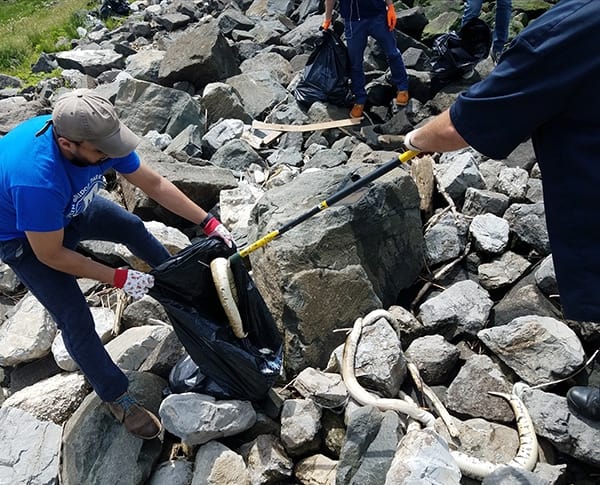
If you stumbled upon a cluster of decapitated snakes in a park, what would you do?
This bizarre question confronted
Brooklyn Bridge Park Boathouse (BBPB) volunteers on a cleanup day at Valentino Pier on Saturday morning, May 6. The beach cleaners found around five to seven lifeless – and headless – snakes on the rocks just south of the pier.
“It wasn’t one person’s snake collection. That’s a lot of snakes for one person’s Brooklyn apartment,” said Todd Seidman of Red Hook Boaters. Though not present at the pier on May 6, Seidman helped orchestrate a post-discovery discussion about the mysterious reptiles with locals over email.
One of the volunteers called 311 on May 6. New York City Department of Parks & Recreation responded to the request and disposed of the reptiles in large black bags.
Noah Diary, President of BBPB, recalled one of the NYC Parks representatives mentioning that the snakes would be taken to the city’s Animal Control & Welfare and undergo necropsies, also known as animal autopsies.
“The idea was that they would open them up and see if there were microchips,” Diary says. Implanting microchips into pets is a common practice for pet owners to track lost animals.
NYC Parks did not respond to inquiries regarding whether the animals received necropsies. The city agency is unable to speculate how the snakes ended up at the pier.
BBPB and Red Hook Boaters are both volunteer-run nonprofits. The former offers free “human-powered boating” around Brooklyn Bridge Park. Red Hook Boaters launch their gratis kayaking sessions from Valentino Pier.
An expert weighs in
Adrian Reuter, Latin America Regional Wildlife Trafficking Coordinator at the Wildlife Conservation Society (WCS), viewed a few photos of the suspicious serpents over an email exchange with BBPB.
“I’d say most were adult ball pythons, at least one female, and perhaps one rock python as per the skin pattern and sizes. Both species [are] very common in the pet trade and also commonly bred in captivity,” writes Reuter.
In New York City, pythons are illegal to sell or keep as pets.
Judging from the pictures, Reuter says the creatures appear less valuable than snakes with more elaborate colorations. “In my opinion these were snakes from captive origin,” the wildlife expert adds. “Clearly nonnative species.”
Prior to WCS, Reuter spent five years as the Mexico and Central America representative for TRAFFIC, a non-governmental network that monitors the wildlife trade.
With limited information available to him, Reuter says that animal trafficking is unlikely the cause of the Valentino Pier discovery.
“Given the little commercial value of the specimens found…it would make little sense to traffic big heavy adult individuals to obtain little gain per weight/volume,” he writes.
Decapitation would indicate “deliberate killing of the individuals and just the objective to get rid of them with no trace of who did it,” Reuter reasons.
As solitary animals, the snakes likely perished before they were lumped together on the rocky shore.
Odd precedent
The May 6 discovery of dead snakes in Red Hook isn’t the city’s first encounter of this nature.
A 10 foot long dead boa constrictor was found in a Bronx high school parking lot in December 2016, NY Daily News reported. NYPD’s Emergency Services Unit removed the mysterious animal.
“If you see an injured or dead animal in a park, the best thing to do is leave the animal where it is, give it some distance, and call 311,” writes a NYC Parks spokesperson in a statement. “The more information you can provide 311, the better. NYC Parks does not determine the cause of death of animals.”








